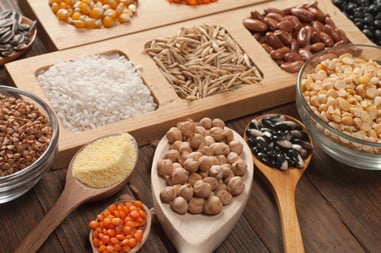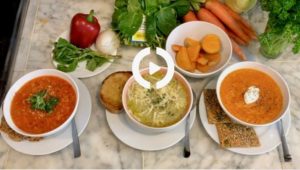In our last issue, we shared one of the best tips about shopping in a grocery market – stick to the real food around the perimeter! Now we share how to use the center aisles to best support your health and weight loss! The secret is… find the basic whole foods that will best prepare YOU for your ready-to-cook adventures. If you have the items you need on hand, you will be more likely to cook at home, and less tempted to order take-out or head out to eat!
The goal is to build your pantry with items that will naturally last a long time, and be there for when you have the inspiration to cook. First, we’ll cover a few tips on how to get what’s good, and bypass all the products not designed with your health in mind. Then we’ll give you some examples of pantry categories and specific items to begin to play with!
5 tips on how to navigate the aisles to find real food for your pantry
1) Begin with a quality meal before you head to the grocery store. This reminds you of how good it feels to eat for your health and guarantees that you won’t be driven by your immediate hunger.
2) Arrive with a list, or a general idea, of what you need (see basic pantry categories below.)
3) MOST IMPORTANT: Pass by the items that have refined sugars and flours and unpronounceable ingredients! Just do it. Keep moving. Your goal is to find real food (even in the midst of packaged products of questionable repute).
4) Aim for 3-4 different types of food items for each category in your pantry. Variety is key to having a pantry that is flexible day to day, week to week, recipe to recipe.
5) Try something new! It’s ready for you whenever you’re inspired!
Start Now! Create your pantry with the important basic categories, which can include a variety that changes over time! Start with 3-4 in each category!
1) REAL FATS AND OILS. Key to any meal. For example: butter, olive oil, coconut oil, nut oils, ghee.
2) WHOLE GRAINS. Easy base to use in many dishes. Examples: brown rice, quinoa, basmati rice, barley, black rice, amaranth, oats, millet.
3) WHOLE NUTS AND SEEDS. Many ways to use in sauces, salads, or atop most meals! Examples: walnuts, hazelnuts, peanuts, almonds, cashews, Brazil nuts, pecans, pumpkin seeds, sesame seeds, sunflower seeds, poppy seeds. Nut butter.
4) WHOLE BEANS. Dried. Or canned. For example: kidney beans, pintos, garbanzos, black beans, great northern, white beans, red beans, lima beans, lentils.
5) SAUCES & BASES. Common additions to many dishes, to be finessed by your own evolution into a cook, and the flavors you like. Examples: apple cider vinegar, bone broth, spices and herbs, vanilla, honey, maple syrup, cocoa powder, coconut, soy sauce, almond flour,
6) CANNED GOODIES. Make these special items you like, that can serve as a base to a meal or an exciting accent! Designed to last. Examples: tuna, salmon, trout, clams, sardines, pickles, olives, capers, artichoke hearts, olive tapenades, olives, roasted red pepper, canned tomatoes.
7) FROZEN GOODS. Of course fresh is best, but when it comes to fruit and veggies, if you don’t have anything fresh at hand or if a certain ingredient is out of season and expensive, this is the next best way. Can easily throw into a soup, a meal, or heat up in a pan. For those beginning to cook, a frozen meal can be a base you can add to and build upon. Examples: green beans, peas, broccoli, cauliflower, strawberries, raspberries, blueberries.
Need more space in your pantry? It may be time to get rid of the items that you can’t recognize as growing from the earth! Feel bad wasting food? Do you prefer those foods to go inside of you and your family or in the trash?! Go for it!
Remember to include some favorites! Some new items! Some comfort food treats! You’ll be set for the season.









